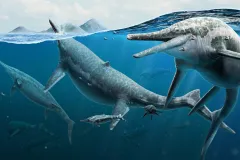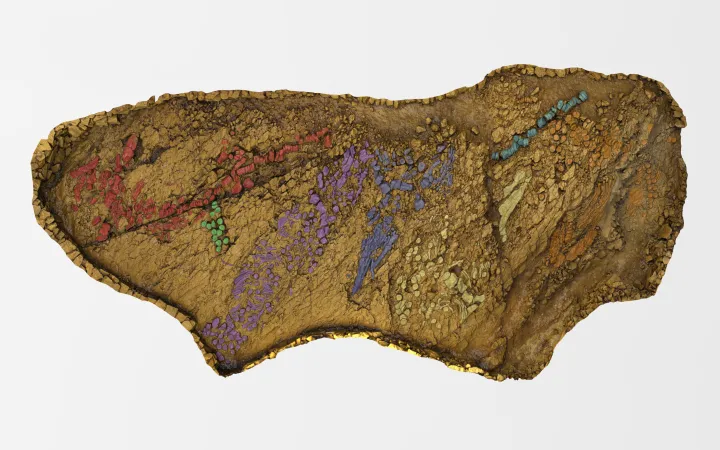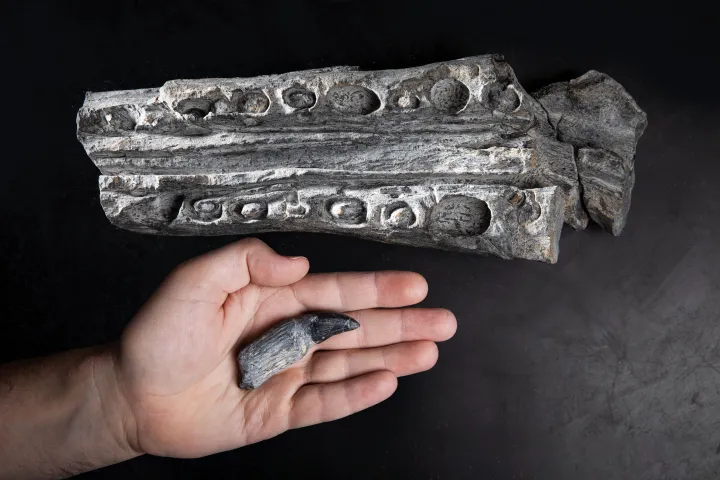Mystery of An Ichthyosaur Graveyard Revealed

In the middle of the Nevada desert, 300 miles from the nearest ocean, there is a massive gravesite containing the fossilized skeletons of dozens of ancient sea giants that lived 230 million years ago. With slender yet muscular bodies, these reptiles— ichthyosaurs—resembled today’s dolphins with their elongated snout, erect dorsal fin on their back, and a tail fluke used to steer and propel them through the water. The collection of so many skeletons in one place has puzzled scientists for over half a century and now, with the help of modern technology and some clues found in rocks, we may have an answer.
Why they died still remains a mystery, but new research (and knowledge of their modern-day counterparts, whales) now brings us closer to answering why so many ichthyosaurs congregated in the exact same spot across hundreds of thousands of years. It also reveals a key part of ichthyosaur behavior: for many generations the reptiles migrated from across the ocean to the area for a specific purpose—to birth and rear their young.
During the Triassic, Jurassic, and Cretaceous periods, when dinosaurs reigned on land, sea reptiles lived in the ocean. Mosasaurs, plesiosaurs, and ichthyosaurs were the largest of the marine reptiles, with some reaching sizes similar to today’s small whales. Ichthyosaurs share many of the same characteristics as whales and dolphins. All are large predators with streamlined bodies optimally built for life at sea and they also give live birth to their young. But while scientists can observe whale behavior in real life, everything we know about ichthyosaur behavior must be learned from the bones they’ve left behind.
The mass gravesite in Nevada was likely first discovered by miners searching for silver. In the late 1800s surveyors found traces of silver in the area and soon a mining company was formed and a small town, Berlin, established nearby. Local residents built their home hearths with some of the ichthyosaur bones, though they likely didn’t know what they were actually unearthing. It wasn’t until Stanford scientist Siemon W. Muller came upon an eroded hill above the then deserted mining town of Berlin in 1928 that the identity of the fossils was understood. Over a hundred years earlier in England, Mary Anning discovered the first ichthyosaur skeleton, and the bones in Utah were clearly a close relative. By the 1950s, the site was partially excavated by Charles Camp of UC Berkeley, revealing the skeletons of 37 massive ichthyosaurs. At the time they were the largest ichthyosaurs discovered, reaching lengths of 49 feet. Camp named them Shonisaurus popularis for the Shoshone mountain ridge that rises above the dig site. Some skeletons were carefully removed from the bedrock and stored in museums, but a handful were kept in place for public display.
Recently, Smithsonian scientists returned to the gravesite to try and figure out the decades-old mystery of why so many of the reptiles died in the same spot. In addition to traditional paleontological tools, they also brought high tech cameras and scanning equipment that stitched together a three-dimensional image of the gravesite so they could study the fossils from afar, away from Nevada. In this case, there is no smoking gun. Like detectives collecting evidence at a crime scene, the researchers pieced together a picture of what happened to the ichthyosaurs through a process of elimination.
A key source of evidence was the surrounding rocks, or strata. By looking at the mineral makeup of the rocks near the bones they were able to rule out a catastrophic natural disaster (like a volcanic eruption or earthquake). Mercury levels, which indicate a volcanic eruption, were normal through the sequence of rocks that contain the ichthyosaur skeletons, and when they looked for evidence of a mass die-off of marine life, the geochemistry showed no indication of such an event. A popular idea is that the ichthyosaurs stranded themselves onshore, potentially during an extreme low tide. But previous studies have shown that the sediment where the ichthyosaurs died was from a deep-sea environment, and not a coastal one, ruling out a shoreline death.
Then they found baby ichthyosaurs. Far from the dig site, in a museum collection of fossils gathered decades before, they discovered the parts of very small skeletons. Further examination using micro x-ray CT scans revealed them to be embryonic and newborn ichthyosaurs. An assessment of all the ichthyosaurs at the site showed that there were adults and young, but no juveniles. Combined with the knowledge that there were no significant sources of food to lure them to the site, a picture began to emerge: like whales and sharks today, ichthyosaurs over 200 million years ago congregated at a specific location to give birth and rear their young.
“Finding these different spots with the same species spread across geologic time with the same demographic pattern tells us that this was a preferred habitat that these large ocean-going predators returned to for generations,” says Nick Pyenson, Smithsonian National Museum of Natural History paleontologist involved in the research. “This is a clear ecological signal, we argue, that this was a place that Shonisaurus used to give birth, very similar to today’s whales. Now we have evidence that this sort of behavior is 230 million years old.”
Nursery habitats often provide a safe place for pregnant mothers and newborns. Gray whales choose the lagoons off of Baja California for the calm seas and warm water, while North Atlantic right whales prefer shallow waters near Cape Canaveral, Florida. Often, generation after generation return to the same place with new mothers following the same migration patterns as their mothers and grandmothers before them. It seems likely that millions of years ago ichthyosaur mothers did something similar, showing the burdens and responsibilities of motherhood transcend the ages.



